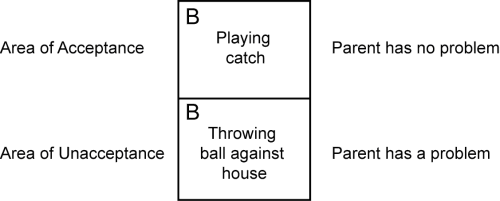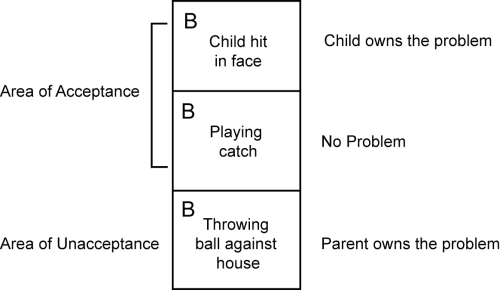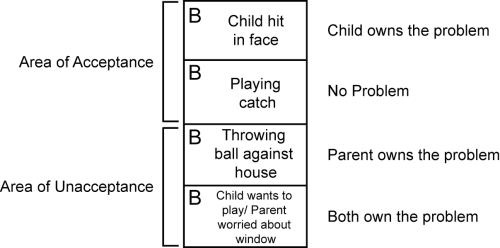
By Thomas Gordon, Ph.D.
I have been asked frequently how and when I came up with the various components of what is often called the “Gordon Model.” This model of effective relationships is taught in all of the training programs offered by Gordon Training International, including Parent Effectiveness Training, Teacher Effectiveness Training and Leader Effectiveness Training.
GROUP-CENTERED LEADERSHIP
I first called the model “group-centered leadership.” As a graduate student at the University of Chicago, I was asked by my professor and mentor, Dr. Carl Rogers, to contribute a chapter to a book he was writing. I had become interested in the field of leadership while attending the National Training Laboratory (NTL), the birthplace of the “group dynamics” movement. Rogers saw that my model of leadership was an application of his new client-centered psychotherapy methodology.
His book was titled Client-Centered Psychotherapy: Its Current Practice, Implications, and Theory. It helped make Carl the most famous and respected psychologist in the world. “Group-Centered Leadership and Administration” was the title of my chapter. I remember clearly the hours I spent reading everything I could find about leadership. The beginning of the Gordon Model can be seen in these concepts described in that chapter:
- Leadership is a set of functions that are the property of the group and should be “distributed” to group members.
- The most effective leader is one who creates the conditions by which s/he will give up the typical leadership role and become more of a group member. Consequently, group members will then carry out some of the functions of the leader.
- Group problems require “participative group problem-solving.”
- Leaders should create the conditions in which all the members feel safe to communicate their ideas and feelings.
- Group-centered leaders need to set a model of attending to others by using “reflection of feelings and meanings” or “empathic listening,” the principal skill used by client-centered therapists.
- Group-centered leaders must convey “acceptance of the members’ communication.”
Before I earned my Ph.D. degree, I was given an appointment to the faculty of the Psychology Department at the University of Chicago. There I intensified my interest in leadership by conducting a leadership training program and doing weekly consulting with a small manufacturing company in Davenport, Iowa. These experiences motivated me to try writing my own book. It was very hard work for me, but I was confident that I was getting close to a definition of democratic leadership. In that book, published in 1955, I added to this model the following concepts and methods:
- The “wisdom of the group,” my phrase to describe the creative resources of group members.
- A four-step problem-solving process I developed to help groups tackle problems more systematically and effectively:
- Recognizing and defining the problem
- Diagnosing the problem
- Making the decision
- Accepting and carrying out the decision
- The leader’s limits and group’s “area of freedom,” I represented in a diagram. My consulting work taught me that leaders have limited areas of freedom beyond which they are not authorized to let their group make certain action decisions.
Active Listening
The skill of reflecting back the meanings and feelings of group members in order to test out the leader’s understanding of their messages (empathic listening). Carl Rogers referred to it as “reflection of feelings.” I had learned how to do this effectively while a staff member of the University of Chicago Counseling Center in 1946-47, where I did counseling with students. Previous research had shown this skill encouraged clients to talk freely about their problems. Someone later suggested I call it “feedback,” a term used in electronics.
The 12 Roadblocks
The “Communication Roadblocks.” I needed a dissertation to complete the research requirement for my Ph.D. degree. One or two studies by students of Carl Rogers had identified several responses used by therapists which blocked the client’s communication. I added several more “communication blockers.” That list would later become the twelve “Communication Roadblocks” in my first leadership training program in 1957.
A COURSE FOR PARENTS
However, this developing model of leader-member relationships was validated for me when I conceived the idea of developing a training program for parents in 1962. I was also beginning to focus on the amazing similarity between typical leader-member relationships and those between parents and their children. Both were “dominator” relationships in which rewards and punishments were used by the dominator to control the other’s behavior.
In the first few parenting classes I taught, I concentrated almost entirely on teaching parents to use empathic listening to respond to their children’s feelings and problems. It had worked so well when, as a counselor, I used it with my clients to help them find their own solutions, so why not teach parents this listening skill to empower their children to become good problem-solvers? I got lots of feedback of the amazing effectiveness of this kind of listening. Later I adopted the name “Active Listening” from an article written by a former student, Richard Farson.
I-Messages
Understandably, parents in these early classes started asking: “What do we do when a child’s behavior causes us a problem?” Because in therapy clients seldom cause their therapist a problem, nobody had come up with a good way of dealing with this situation “therapeutically.” My colleague and friend, Oliver Bown, had also been thinking about this, recommending that client-centered therapists should be “open, honest, and direct.” I also recalled a book I had read called The Transparent Self , by Sidney Jourard. He advocated this kind of openness in all relationships: “Persons who withhold their real selves from others and instead strive to manipulate them in one way or another do violence to their own integrity as well as that of their victim.”
I also recalled my experiences doing play therapy, when youngsters wanted to do something that would mess up my room or break a doll or toy. What did I say? Well, I told them non-blamefully how their behavior would impact me. For example, “When you throw sand out of the sandbox onto my rug, I have to spend a lot of time cleaning it up and I don’t like that,” or “I can’t be with you any longer because I have another person waiting to see me.” I began calling them I-Messages, as I recall, because I was the person with the unmet need. I-Messages were added to the model in my first book for parents, P.E.T.: Parent Effectiveness Training (1970).
In 1976, my wife, Linda Adams, designed a course titled Effectiveness Training for Women. Three years later she wrote the book by the same name. They both brought important additions to the Gordon Model. With the purpose of encouraging women to take more responsibility for their own lives, Linda expanded self-disclosure by adding three new I-Messages: Declarative, Responsive, and Preventive. She re-named the three-part I-Message, the Confrontive I-Message. In addition, she developed guidelines for persons to overcome anxiety, which often prevents them from sending I-Messages.
In 1989, in response to men telling her they needed to learn these skills too, Linda developed a second version of this course that included men. She also revised the Effectiveness Training for Women book and entitled it Be Your Best.
Shifting Gears
The addition of I-Messages to influence children to change behaviors that cause parents problems soon led to the addition of “Shifting Gears” in my model. In the P.E.T. book, I described how I-Messages sometimes give the child a problem–making him or her get defensive, blame someone else, feel guilty, or even cry. And I now had to teach parents to use Active Listening when a child shows such responses to I-Messages. I wrote: “I-Messages can give the child a problem (as these messages usually do). So now is the time to show understanding and acceptance, since your I-Message has caused the child a problem.” Often children only then will modify their behavior. Usually all the child wants is understanding of his/her feelings–then is willing to do something constructive about your problem.
Soon, this shifting from I-Messages to Active Listening began to be called “Shifting Gears,” to convey the action of shifting from “going forward” when you confront another to “backing off” with Active Listening.
Method III Conflict Resolution
It didn’t take long to learn that I-Messages sometimes fail to influence a person to change behavior, even after you have Shifted Gears to Active Listening. Now what? Clearly now it is the relationship that owns a problem–in fact it is a conflict. I had read about the six steps of solving problems creatively that were used by the famous educator and psychologist, John Dewey. I added those six steps to my relationship model as a procedure for resolving conflicts peacefully. Another colleague and friend, Jim Craig, later urged me to adopt the term political scientists were then using–No-Lose or Win-Win Conflict Resolution.
Two important ideas were soon added to the six steps of this No-Lose Conflict Resolution Method. The first was stressing that in Step I, Defining the Problem, it is important to define it in terms of conflicting needs, not conflicting solutions. The second was stressing that there should be no evaluations of any of the solutions brainstormed in Step II, a requirement I had learned from my friend, Charlie Clark, a pioneer in the field of creativity.
Values Collisions
Before long in my classes some parents gave examples of conflicts that their teenagers refused to problem-solve with the parents. Invariably these involved behaviors of the youngsters that had no “tangible or concrete effect” on their parents. They were conflicts of values, beliefs, or strong preferences of the youngsters. Clearly, such values conflicts occurred quite often in most families. So what can parents do? Over time we added some non-power ways to deal with “values collisions,” and later our then P.E.T. Director, Mel Kieschnick, suggested a barometer to represent the varying degree of risks of these non-power alternatives.
The Behavior Window
Its origin was in one of the very early P.E.T. classes I taught in the late 1960’s. I remember asking a class to imagine standing at a window watching their child playing catch with a friend in the backyard. Most of the class members felt that the behavior (B) they observed was acceptable to them–no problem. I suggested that this behavior will be seen through the top part of the window, which I called their “area of acceptance.” Now, if the kids start throwing the baseball against the house, near the window, that behavior (B) will most likely be unacceptable because it causes the parent a concern or a problem. I recall I drew the window like the graphic below.

Sometime later in another class I recall adding a third area in the window. In that area, parents would see their child get hit in the face by the baseball thrown by the friend. The child starts crying loudly. Now the child “owns” a problem.
Some years later, Linda influenced me to add a fourth area for the times when conflicts occur in a relationship. The child wants to play ball and there’s no one to play with so the child begins throwing the ball against the house which causes a problem for the parent who’s afraid a window will get broken. Now, they both “own” the problem.
The “Behavior Window,” or Behavior Rectangle as I first named it, was an integral part of the P.E.T. book (1970). The concept of “problem ownership” and its relationship to acceptance and unacceptance of a child’s behavior became the central integrating component of the P.E.T. course and subsequently for all the other courses created by Gordon Training International. When I later used the Behavior Window to designate what communication skills one should use (Active Listening or Confrontive I-Messages), the value of that visual increased even more.
The concept of problem ownership together with the appropriate skills of Active Listening, Confrontation (I-Messages) and No-Lose Conflict Resolution would eventually have a profound influence on the parent training movement in the U.S., as judged by the frequency of its assimilation into so many other persons’ training programs–not only those for parents but also those for couples, teachers, organizational managers, sales people, health care professionals, and so on.
The Behavior Window also was the structure on which I later wrote the Credo for My Relationships with Others, sometime in the late 1960’s. I can’t be certain but I believe I was inspired to write the Credo by Kahlil Gibran’s beautiful poem in The Prophet , which begins with: “Your children are not your children…” I also wanted a brief summary of the key skills taught in P.E.T.–something at the end of the course to give to parents as a reminder of what they learned in the class.
A COURSE FOR LEADERS
While the P.E.T. course was spreading rapidly throughout the country, taught by over a thousand instructors we had trained and authorized to teach it, the climate in industrial organizations began to change rapidly. “Participative leadership,” “problem-solving teams,” and “democracy in the workplace” were being heard more often. These changes influenced me to design and market a new course for leaders.
Fortunately, I felt I was ready to do this largely because of a long and very successful consulting relationship I had with a Los Angeles company of nearly one thousand employees. In that relationship, which lasted for twelve years, the CEO, Fred Llewellyn, gave me the opportunity to introduce and try out many new ideas and procedures. He would give me new problems and I was expected to come up with solutions. And I worked in every division of that organization.
I incorporated in this new Leader Effectiveness Training course the same basic relationship model as the one in P.E.T. But I added new learnings from being a consultant with this company. L.E.T. eventually was taught to all their managers and supervisors, and communication skills and the Credo were taught to the rest of their employees. That organization was Forest Lawn Mortuary and Memorial Park in Glendale, California, the national leader in its field.
Periodic Planning Conference
I also developed for Forest Lawn a substitute for the much hated and ineffective annual or semi-annual performance evaluation. It was a forward-looking procedure that encouraged worker participation to define and solve problems in a multi-level division or company–a procedure I used successfully in several different corporations. Both of these procedures are described in my L.E.T. book. I also developed a sales training course that taught this company’s salespeople the skills for developing a “partnership relationship” with their customers and eliminated the traditional “sales techniques” for controlling the buying process.
UNIVERSALITY
In conclusion, I want to emphasize the universality of the Gordon Model, a fact that I had not anticipated. Now we know that our training programs, as well as my books, have been successful in 43 countries, each with a different culture. Our instructors in those countries, however, have found it unnecessary to make changes in the overall model or in any of the specific skills and concepts. This has given me the confidence that such values as equal rights, respect for the needs of others, cooperation in relationships and peaceful resolution of conflicts may someday become universal.
In 2022, Gordon Training International celebrated 60 years! We made a short video about our pretty amazing history!
For more information, please contact us:
Tel: 800.628.1197
Em: info@gordontraining.com



